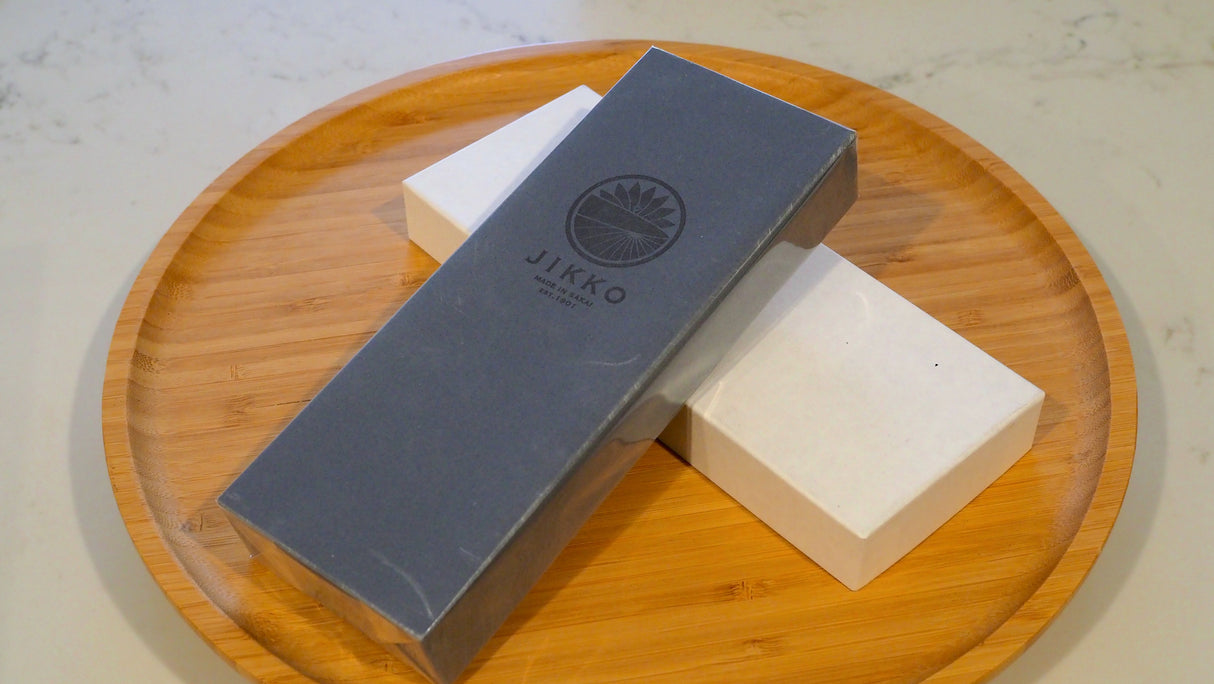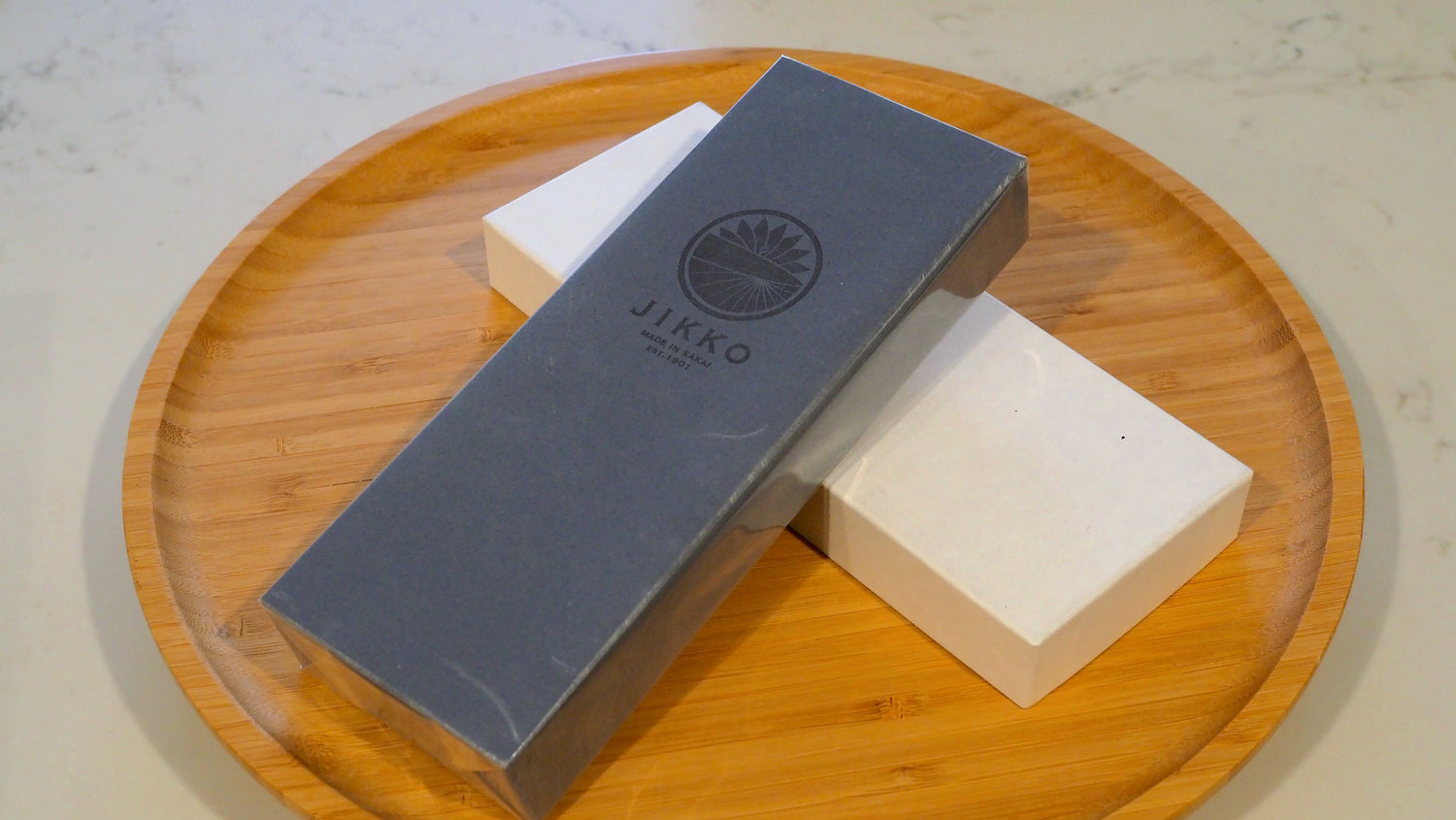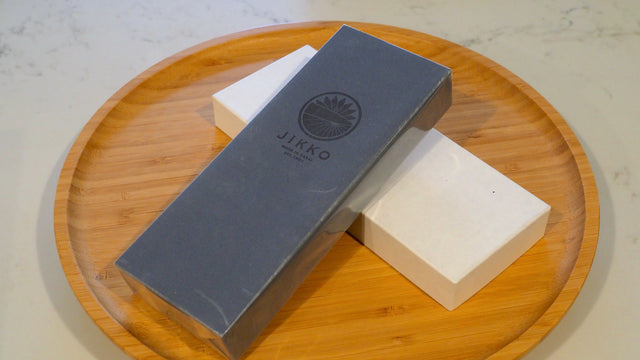Sakai Jikko Ceramic Whetstone #1000
Couldn't load pickup availability
Whetstone specification
Length: 20.5cm, Width: 8cm, Height: 3cm
Vitrified manufacturing method (#1000) - heat treated with very high temperature (1200-1300°C), allowing higher grinding performance than those made with resinoid method (Jikko ceramic #400/#3000/#6000/#10000/#13000).
Soak in water for 5-10 minutes before use.
Ceramic sharpening whetstone #1000. Ceramic is harder material than normal stones and it reduces your time for sharpening. #1000 is good for usual maintenance.
Jikko ceramic whetstone - suited for beginning to advanced users
Jikko ceramic whetstones are specially selected abrasives hardened in a special manufacturing method (vitrified or resinoid method). They are ideal for kitchen knives made of hard steel materials such as V10, silver3, powdered high speed steel, and blue steel, which can be difficult to sharpen with conventional synthetic whetstones.
Since it is not too hard and has a smooth sharpening feel, it is suitable for beginners. You can sharpen quickly and satisfactorily with excellent grinding performance. The sharpening quality dose not change even if the whetstone becomes thin and you can benefit the stable quality until the very end.
Why knives get dull
There are no knives that retain the best sharpness without sharpening. But why do knives lose sharpness? It is simply because of abrasion on the edge.
Edge abrasion occurs when it cuts food and hits a chopping board. (For saving long lasting edge, we recommend wooden boards over plastic ones) Each time you cut vegetables or meat, a sharp edge gets more rounded and dull through abrasion. Unfortunately, we cannot see how much the edge is worn off without a microscope.
Why not steel but whetstone?
For many knife users, honing steels are the popular choice. But in terms of retention of sharpness, it does not give good effects. On the contrary, it ruins a good edge in a long run.
Honing with a steel mainly helps remove dirt and oil from the edge so you may feel the edge is sharp with cleaner cuts. In fact, it has sharpening effects as the edge gets rubbed on a file.
However, it is almost impossible to sharpen with the same angle every time on a steel, so the edge gradually gets rounded shape, which gives adverse effects on edge retention.
If you want to take the full advantage of good knives, meaning not only good sharpness at a time but long lasting sharpness, please consider using flat whetstones for knives, regardless of Japanese, Western or Chinese knives.
Video: How to use sharpening stone.
-
my_fields.specification-
Payment & Security
Payment methods
Your payment information is processed securely. We do not store credit card details nor have access to your credit card information.
Frequently Asked Questions
Shipping
What countries do you ship to?
What countries do you ship to?
We ship orders from Melbourne. As well as everywhere within Australia, we ship to United States, Canada, New Zealand and some European countries. If your area is not listed in the checkout, please let us know.
How long will it take to receive my order?
How long will it take to receive my order?
Shipping timeframe depends on Australia Post. Parcel post shipping normally takes 1-4 days while express post shipping ensures more prompt delivery. International shipping times depend on the destination (estimated at checkout).
Do you bear import tariffs?
Do you bear import tariffs?
No, import tariff and any fees accompanying have to be paid by customers.
Returns and Refunds
How do I return a product?
How do I return a product?
First if all, please contact us by email: info@kazsknifeonline.com.au.
Items must be returned within 30 days after receiving your order. Items must be returned in the same condition in which they were received, be unused, including all the original packaging.
Upon items returned and confirmed to be resalable, we will process a refund for the item.
How long will it take to receive my refund?
How long will it take to receive my refund?
It usually takes 3-5 business days from the time we process the refund until you receive the money.




